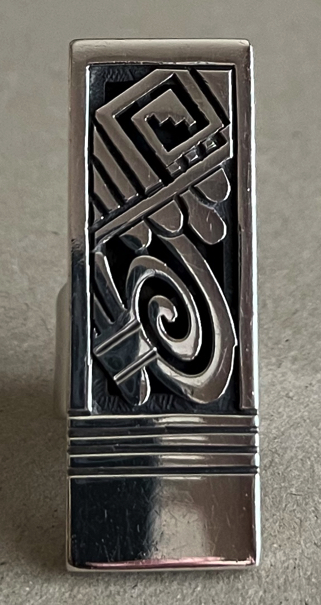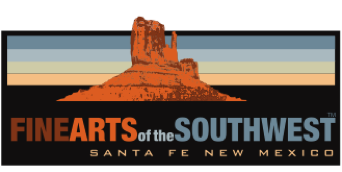
© 2010-2023 by Fine Arts of the Southwest, Inc. All rights reserved.
Unauthorized reproduction or use is strictly prohibited by law.
An exceptional Hopi “triple-overlay” style silver ring by Michael Kabotie (Lomawywesa), c.1990’s to early 2000’s
Some of the most in-demand Native American art in existence today is Michael Kabotie’s (1942-2009) extraordinary Hopi silver overlay jewelry which is coveted and sought after worldwide for its unique and distinctive beauty and intense artistic expressiveness.
Michael Kabotie grew up in one of the most inspiring artistic environments imaginable. His legendary Father,
Fred Kabotie (1900-1986), was one of the most significant Hopi artists and educators of the modern era and the important Co-Founder of The Hopi Arts and Crafts Guild. In that role, along with his colleague, jeweler Paul Saufkie, Fred Kabotie established the enduring tradition of Hopi silver overlay jewelry which would later become one of his son Michael’s primary artistic vehicles.
The unique “triple-overlay” style, which Michael originally developed, allowed him to achieve a far greater sense
of depth, detail and precision in his jewelry than is possible in conventional two-layer Hopi silver overlay.
By variously working the surface with the judicious application of stampwork, chisel work, shading, etching and notching on the top layer of silver and the strategic use of cut-out and tapered panels the piece acquires a marvelous, and intense sculptural quality and vividness of design, almost like a beautifully hand-carved sculptural painting, if you will, vividly rendered by the various artist’s marks into three dimensions.
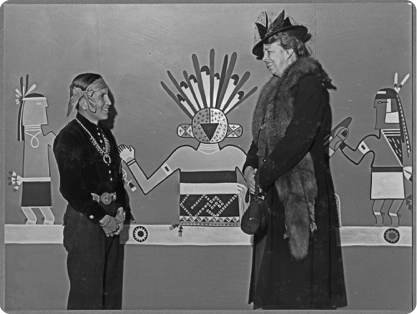
At left, "Mrs. Roosevelt and Fred Kabotie, Hopi painter," standing in front of an Awatovi Kiva Mural reproduction by Fred Kabotie at the Museum of Modern Art, New York exhibition, "Indian Art of the United States", 1941. At center, Michael Kabotie wearing one of the silver pendant/panels of his "Silver Room of Awatovi" 2001 sculpture seen at right on the display in The American Museum of Natural History's 2004-2005 "Totems to Turquoise" exhibition.
Left photo source and © The Museum of Modern Art Archives, New York. IN123.62. Photograph by Albert Fenn. Center and right
photo source and © "Totems to Turquoise", American Museum of Natural History, Harry Abrams, New York, 2003, pp. 176-177.
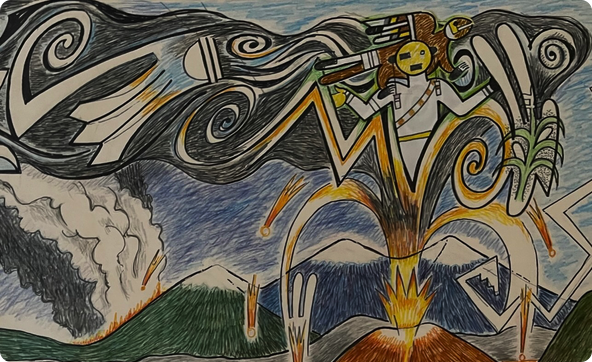
At left, detail of an original Awatovi Kiva Mural reproduced by Fred Kabotie and Louie Ewing, Plate "E", "Kiva Mural Decortations at Awatovi and Kawaika-a" by Watson Smith, © Harvard University, 1952. At right, detail of a 2001 Michael Kabotie Hopi mural study depicting The San Francisco Peaks as being the legendary ancestral home of the Hopi Kachina spirit beings.
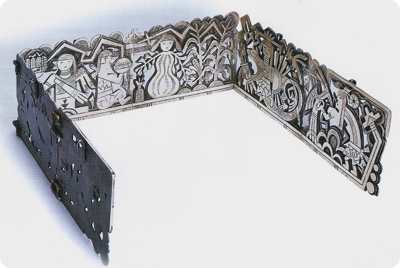


The San Francisco Peaks as seen from the Hopi mesas.
Photo source and © Sacred Land
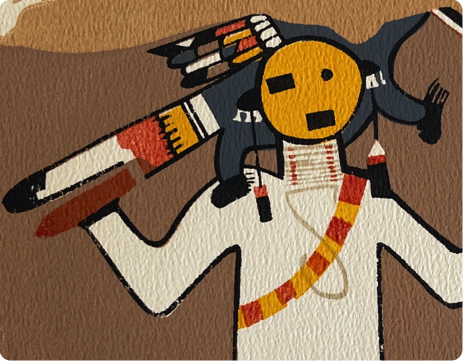
The ring measures a size 7 1/2 on a professional graduated ring sizer. The large rectangularly-shaped silver panel which makes up the ring’s face measures a good-sized 2” in length and is 3/4" in width and 1/8" in thickness. The ring is most beautifully and finely constructed and weighs a very solid feeling yet comfortable and easy to wear 23 grams or 3/4 ounce. The ring is in excellent original condition overall with some age-appropriate abrasions, scuffs and tiny nicks here and there all adding up to a fine, soft patina. The ring is properly and beautifully signed “Lomawywesa”, Michael Kabotie’s Hopi name which means “Walking in Harmony”, in his customary stylish cursive signature on the back. The ring is not dated, but stylistically it is very much in the manner of Michael’s later fully-developed period jewelry pieces, circa late 1990’s to early 2000’s. And, while all Michael Kabotie jewelry pieces are rare and difficult to come by, his rings are especially so. Over the course of our 20-plus year personal friendship with Michael and continuous involvement with his jewelry we have seen a total of only four of his rings, of which this is one.
Since Michael’s untimely death in 2009, the very limited supply of Michael Kabotie jewelry has literally skyrocketed in value. It has almost completely disappeared from the marketplace and on the very rare occasions when something does become available, it usually vanishes very quickly and one can expect to pay quite handsomely for it. Also, it’s nice to know that this is a ring which can just as easily be worn by a man or a woman so you and your significant other can arm wrestle over who gets to wear it and when. No one loses here, of course, the good news is that the ring will work just as well for the wearer as for the admirer. This ring is a rare and excellent opportunity to acquire a particularly beautiful and wearable piece of Michael Kabotie’s unparalleled jewelry made at the height of his very considerable abilities, a rare and beautiful precious prize to be admired and worn with great pride and lasting pleasure.
SOLD
The resounding and compelling artistic theme that informed and inspired Michael Kabotie’s art for most of his life and career were the magnificent ancient Hopi painted Kiva murals discovered in the 1930’s at the ancient ruined Hopi villages of Awatovi and Kawaika-a on Antelope Mesa on the far eastern edge of the Hopi Reservation. Fred Kabotie assisted the 1935-39 Harvard University Peabody Museum archaeological expedition that discovered and excavated these magnificent murals and he interpreted and presented them in a set of original paintings done for The Golden Gate Exposition in San Francisco Bay in 1939 a project in which he was notably assisted by the talented young Hopi artist, Charles Loloma (1921-1991).
These mural paintings are now held in the permanent collection of The Denver Art Museum. Young Michael
Kabotie was completely entranced by the awesome beauty, imagery, majesty and meaning of these sacred Kiva paintings and he subsequently interpreted and reinterpreted them in various ways and forms throughout his life
in his own paintings and drawings and particularly in his spectacular jewelry pieces.
“We the Hopi have a lot to offer from a spiritual standpoint and as a living force. We are hoping that from the presentation of our traditions and from the interpretation of the Hopi way in our art and paintings a new direction can come for American spirituality.”
-Michael Kabotie
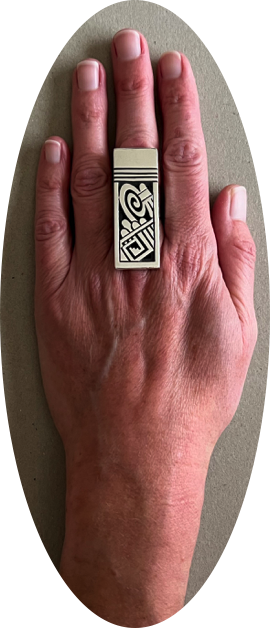
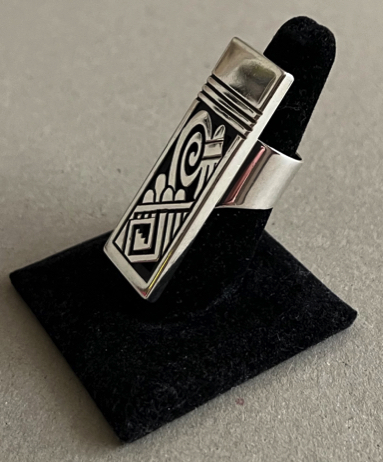
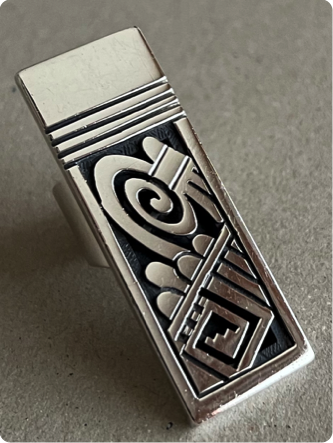
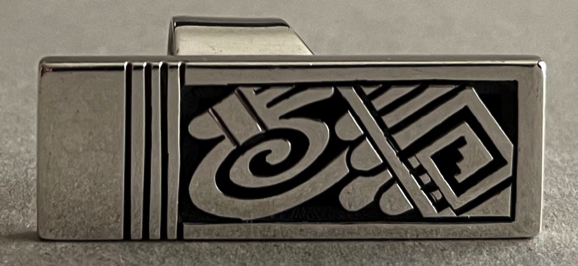
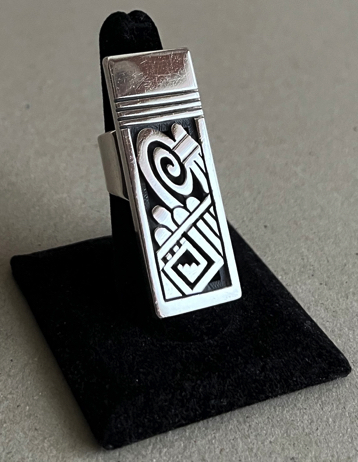
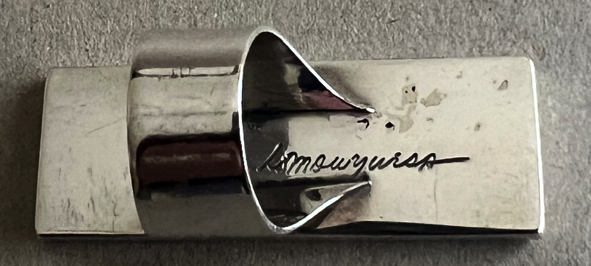
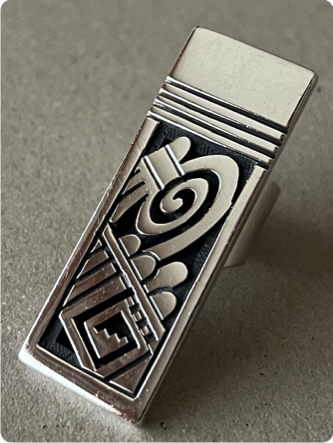
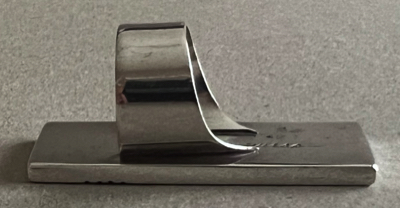
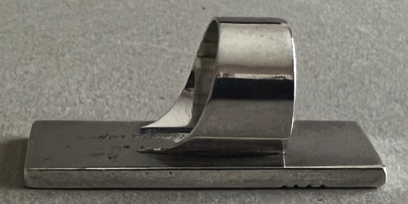
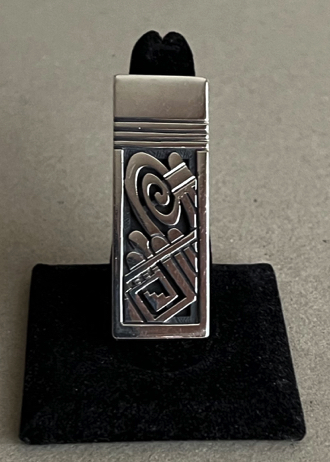
This exceptionally beautiful and dramatic ring is a perfect example, featuring a large rectangular front panel beautifully composed of stylized swirling clouds, rain and windstorms, almost certainly a stylized representation of the sky over the local Hopi Mountain range, the so-called “home” of the Hopi kachinas, the San Francisco Peaks located exactly in Hopi’s backyard, so to speak, just outside of Flagstaff, Arizona. These majestic peaks are central to ancient Hopi mythology and ceremonialism as being the ancestral “Home” of their kachina spirit beings. The Michael Kabotie mural study of a kachina being and its power emerging from its home under the San Francisco Peaks shown above and below illustrates this interpretation very well. The depiction of the swirling sky above the peaks in this drawing is remarkably similar to the graphic design on this ring and the ring presents its front design panel precisely like presenting a painting, just on a finger instead of on a wall.
